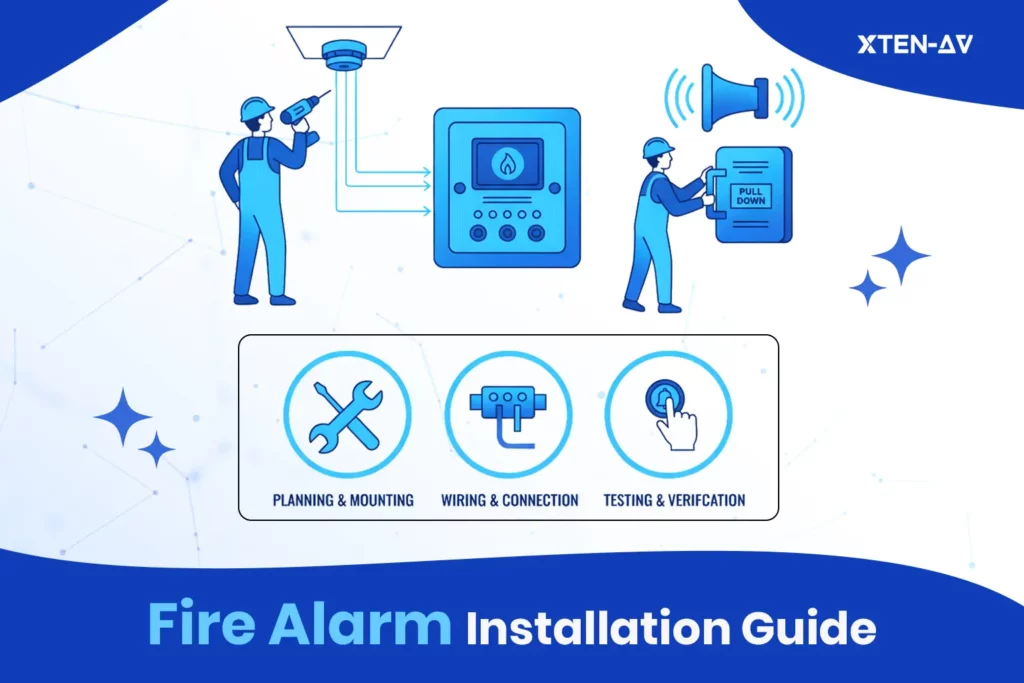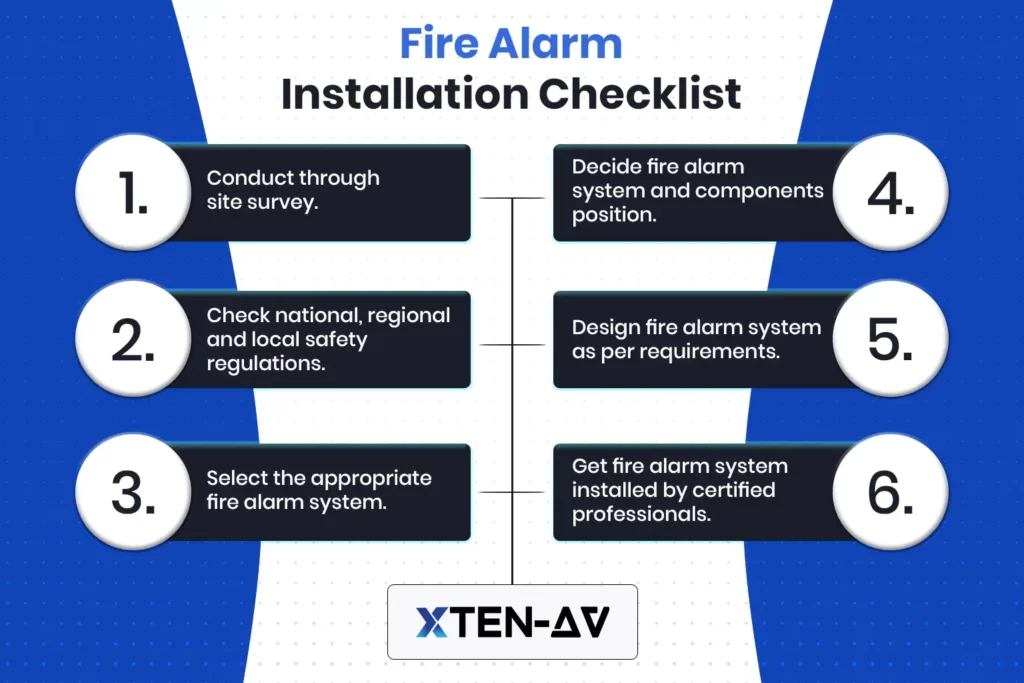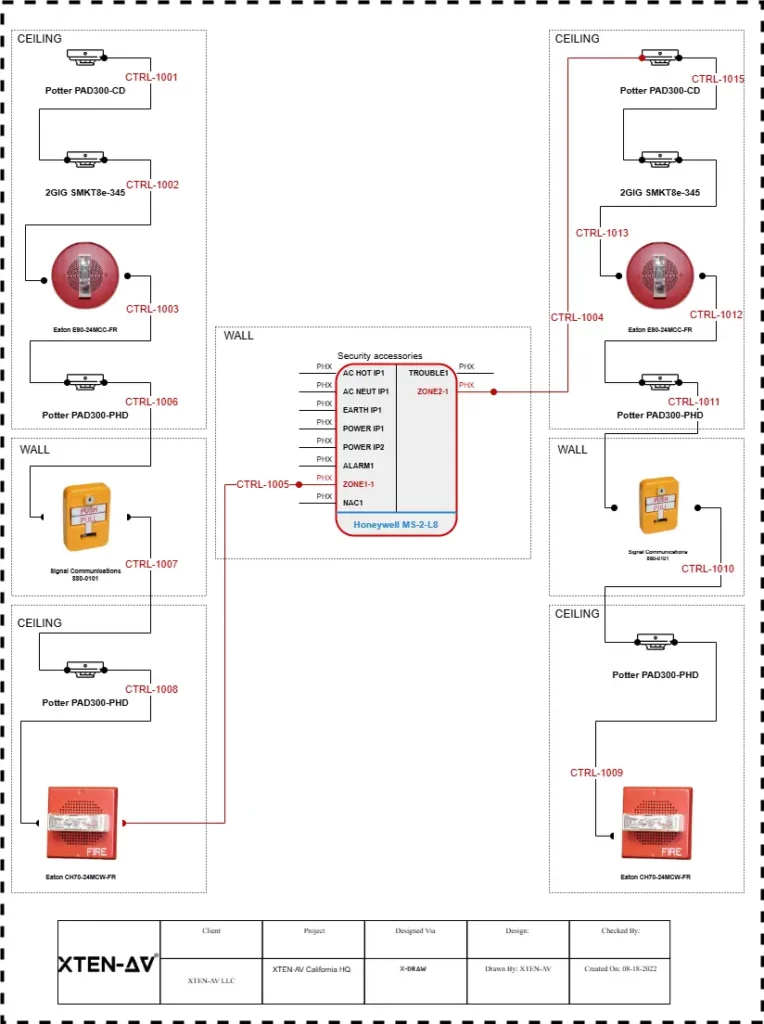Imagine you’re a fire safety consultant brought in on a mid-size commercial project. Before any of the other systems are discussed, the client asks you to take care of the fire alarm system. Afterall, it’s the first step in meeting building code requirements and getting the space ready for use.
Fire alarm system installation takes more than just placing devices around the building. You need to study the layout, identify high-risk zones, and follow local fire codes closely. Each building is different, so the system has to be planned around its unique needs.
Every part of this process matters. A mistake in design, placement, or wiring could affect how the fire security system responds in an actual emergency. This guide breaks down each stage in a clear and practical way. It helps you set up a fire alarm system that works when needed. It also makes sure you follow safety codes and meet real protection standards.
Key Takeaways:
- A fire alarm system is set up to warn people in case of emergency situations. It uses devices like smoke or heat detectors to catch early signs. Once triggered, it sets off alarms so people can leave the area safely. Some systems also send alerts to fire departments or monitoring teams.
- Fire alarm system installation is not a simple process. You need to plan the wiring, follow local codes, pick the right devices, and test everything. The setup has to be clean, accurate, and reliable.
- In most places, only certified professionals are allowed to do this job. In the U.S., NICET certification is common. In the UAE, Civil Defence approval is needed. In Australia, you need a state license or FPAS registration.
- Tools like XTEN-AV can make the job easier. It lets you design layouts, create BOMs, and create code-ready documents.
The all-in-one solution for your AV needs
Transform your audio-visual experience with XTEN-AV.
No Credit Card required
Fire Alarm System Installation Step by Step
You’ve just been hired as a security systems installer for a new mid-rise commercial building. The client’s priority? A reliable fire alarm system setup. Your task now is to take that request and turn it into a working fire alarm system. Here’s how you go from initial need to a fully installed and compliant setup.
Step 1. Building Assessment
Before you start installing, take a walk around the whole site. Check out how the building is set up, what each area is for, and how many people are there during the day. Look out for places that could catch fire, like kitchens, server rooms, or storage areas. Find all the ways out and make sure the emergency signs are easy to see and work well. This look-around helps you plan where to put detectors, control panels, and alarms. A good fire alarm setup needs this step to avoid big mistakes later. It ensures compliance with NFPA 72 rules. This proper assessment helps maintain consistency and security over time.
Step 2: Regulatory Requirements
Every jurisdiction has its own fire code, and as a fire alarm installer, you need to know exactly what applies. Research local building regulations, occupancy-specific fire alarm standards, and documentation protocols. For example, a commercial property may require voice evacuation loudspeakers and fire alarm control panels certified under EN 54 series.
Residential fire alarm system installation may have different smoke detector placement rules. Review NFPA 72 and any regional amendments that affect your project. This step ensures your fire alarm system design meets legal expectations and passes inspections the first time without delays or retrofitting costs.
Step 3: Select the Appropriate Fire Alarm System
The next step in your fire alarm system installation is choosing a system that matches the building’s needs. Does the situation require hard-wired dependability, or will a wireless setup function better? Should you go with addressable systems for large buildings or conventional ones for small layouts?
If you’re unsure, read our detailed guide on the Different Types of Fire Alarm Systems. Tools like XTEN-AV’s fire alarm design tool make this process easier. With access to a 1.5 million product library, you can quickly shortlist control panels, detectors, and modules that meet specs and are available for immediate design use.
Step 4: Smart Fire Alarm Positioning
Once your system layout is planned, the next priority is placing each device correctly. Smoke detectors work best when you install them high up on the ceiling, in the middle of the room, and not too close to corners or walls. This stops detection gaps from stagnant air.
For multi-storey buildings, make sure you put detectors on every level, even in basements and attics. Don’t forget about stairways – they can move smoke between floors during a fire.
Here’s some essential advice for placing your detectors effectively:
Ceiling-mounted detectors need a bit of space from the walls, aim for at least 4 inches out so smoke can actually reach them.
Install alarms on every floor in case of a multi-storey building, especially enclosed stairwells.
You’ll want to focus on spots like kitchens, server closets, and utility rooms where fire risks are higher.
For sleeping areas, one detector should go inside each bedroom and another right outside in the hallway.
Add extra detectors every 30 feet for large open rooms that are over 30 feet across.
Place wall-mounted speakers at a suitable height. Leave some space below the ceiling for extra precautions.
By following these guidelines, you can ensure a faster response during emergencies. Adhering to local fire safety guidelines is essential, too.
Step 5: Fire Alarm System Planning and Design
Start planning your fire alarm system by mapping out the building layout, occupancy type, and critical zones. Your fire alarm system plan should include smoke detectors, heat detectors, and flame detectors. Multi-sensor detectors such as horns, sirens, strobes, and voice evacuation loudspeakers should be included, too. Don’t forget power needs; standby and alarm-load duration calculations should follow NFPA 72 or EN 54 series.
Want speed and accuracy? XTEN-AV makes fire alarm system design easy. Use pre-built templates for different building types or generate a full BoM in seconds with XAVIA’s voice and chat-enabled interface. Whether you’re working on residential or commercial fire alarm systems, these ai cad design tool will help you design faster and stay compliant, without getting bogged down in manual planning.
Step 6: Professional Certification and Code Compliance
Before finalizing your fire alarm system installation, double-check that your design meets the local fire alarm system installation standard. Every region follows its own regulations. In the U.S., it’s NFPA 72. Australia follows AS 1670. UAE enforces Civil Defense codes. Europe follows EN 54. Ensure that your installers are certified and that your design complies with the relevant regional standard. Failing to do this can result in failed inspections, delays, or even legal issues. A compliant fire alarm system ensures smooth project approvals and long-term reliability.
Step 7: Wiring a Fire Alarm System
Wiring is where the real work begins. Use the fire alarm system wiring diagram to understand how smoke detectors, heat detectors, horns, strobes, and the fire alarm control panel all connect. Stick to the right wire gauge; 14 or 16 AWG is usually enough. Follow color codes to keep things clear. Power and signal lines should stay apart to avoid interference. Label every point as you go. On large sites, wiring by zone makes testing and future repairs easier. Whether you’re using a loop or radial setup, don’t guess. Stick to your fire alarm system plan and keep the job neat and traceable.
Note:
In the wiring system, red is for power, black is negative, and signal lines usually go yellow or blue. A clean setup cuts down on installation mistakes and makes maintenance smoother.
Step 8: Integration with Building Automation Systems
As you move through the fire alarm system installation, look at how it is connected to the rest of the building. Your system should shut down the HVAC, trigger elevator recall, and unlock access doors during a fire. Emergency lights and smoke control systems should also kick in automatically. All of this depends on whether your fire alarm control panel supports the right connections. Getting the integration right helps the building respond faster, keeping people safer and cutting down confusion when seconds matter.
Step 9: Power Supply and Backup Requirements
The system won’t help anyone if it fails during an emergency. Fire alarm systems need their own power supply. A circuit that’s separate from other loads and properly marked, is a must. If that goes out, your backup kicks in. Most setups use sealed batteries to give you at least 24 hours of standby time and 5 minutes of full alarm use. Voice evacuation loudspeakers may need more. Whatever you use, test it regularly. That backup power might be the only thing standing between your system and failure when it’s needed most.
Step 10: Regular Maintenance & Testing Protocols
Once your fire alarm system is installed, don’t leave it unchecked. Schedule an annual inspection with a certified fire alarm installer. They’ll test smoke detectors, horns, strobes, and your fire alarm control panel to make sure everything is responding properly. Backup batteries should also be checked and replaced if needed.
Throughout the year, you’ll need to test detector sensitivity, update control panel software, and document any changes. Your maintenance records should clearly show what was done, when, and by whom. This includes battery replacement dates, system modifications, and any corrective actions taken.
For commercial fire alarm systems installation, many authorities require you to submit these records annually. Staying consistent with your fire alarm system monitoring and routine checks keeps your fire safety system ready, especially during emergencies when it matters most.
What are the Components of a Fire Alarm System?
There are many components of a Fire alarm system. Each part has an important role. Together, they help detect fire early and alert people quickly.
The control panel is the main unit. It receives signals from sensors and sends commands. It also shows system status and stores event data.
Initiating devices come next. These include smoke detector installation, heat detectors, and manual pull stations. They sense danger and send a signal to the panel.
Notification appliances warn building occupants. These are horns, strobes, and sometimes voice alert systems. They help people evacuate safely.
Power supply is another key part. Most systems use the main power source, but also need backup batteries. This keeps the system running during outages.
Some systems also have communication modules. These send alerts to a monitoring center or fire department. They may use phone lines, cellular, or internet connections.
All fire alarm system components must follow local building and fire codes. Proper placement and testing are just as important as including relevant parts in the fire alarm installation process.
Do fire alarm installations require certified professionals?
Yes, in most places you’ll need someone certified to install a fire alarm system. Rules vary, but you’ll run into trouble if you skip this step.
In the United States, many states and cities require technicians to be NICET-certified in Fire Alarm Systems. That certification shows they’ve got hands-on experience with wiring, layout planning, and testing. Local authorities often require it for permits or large project bids (according to FireAlarm).
Over in Europe, BS 5839 standards expect installers to prove their skills before working on a system. Fire alarm installation companies train their staff to meet this standard and stay compliant (see BAFE).
According to a source, in the UAE, Civil Defence only allows certified contractors to install or sign off on fire alarm systems (see YellowPages UAE).
Down in Australia, you usually need an electrical licence plus accreditation through schemes like FPAS before working on fire alarm systems (see FPA Australia).
When you hire certified professionals for fire alarm installations, inspections go smoothly, and you reduce the risk of future issues.
How Does XTEN-AV Streamline Your Fire Alarm System Installation Process?
When you’re working on a fire alarm system, speed and precision matter. XTEN-AV makes fire alarm system installation easier by keeping everything in one place. You design, plan, and generate documentation without switching between tools or platforms.
Start with X-DRAW. It lets you upload a floor plan or sketch one out yourself. You can place smoke detectors, horns, strobes, and call points directly onto your layout. It’s easy to move things around or change device spacing.
Whether you’re planning a small unit or a multi-floor building, X-DRAW helps you stay accurate and organized.
Once your layout is ready, move to XAVIA, the voice and chat assistant. You can ask questions during the design stage, like what wire gauge to use or how many detectors you need based on room size. XAVIA AI assistant understands your project’s intent and gives you fast answers on product compatibility, BoM accuracy, or compliance with fire safety codes. You don’t need to search through manuals or look up specs elsewhere.
Finally, use X-DOC to turn your entire plan into a complete proposal. It pulls your drawings, product list, and pricing into a professional format. You can include datasheets, brand-specific models, and even your company’s logo. The document is client-ready and saves hours you’d otherwise spend formatting or rewriting.
By using these tools together, you speed up every stage of your fire alarm installation process while reducing errors and staying compliant.
The all-in-one solution for your AV needs
Transform your audio-visual experience with XTEN-AV.
No Credit Card required
AV Design Mastery + Winning Proposals = 10x Productivity!
- ✔ Automatic Cable Labeling & Styling
- ✔100+ Free Proposal Templates
- ✔ Upload & Create Floor Plans
- ✔1.5M Products from 5200 Brands
- ✔ AI-powered ‘Search Sense'
- ✔Legally Binding Digital Signatures
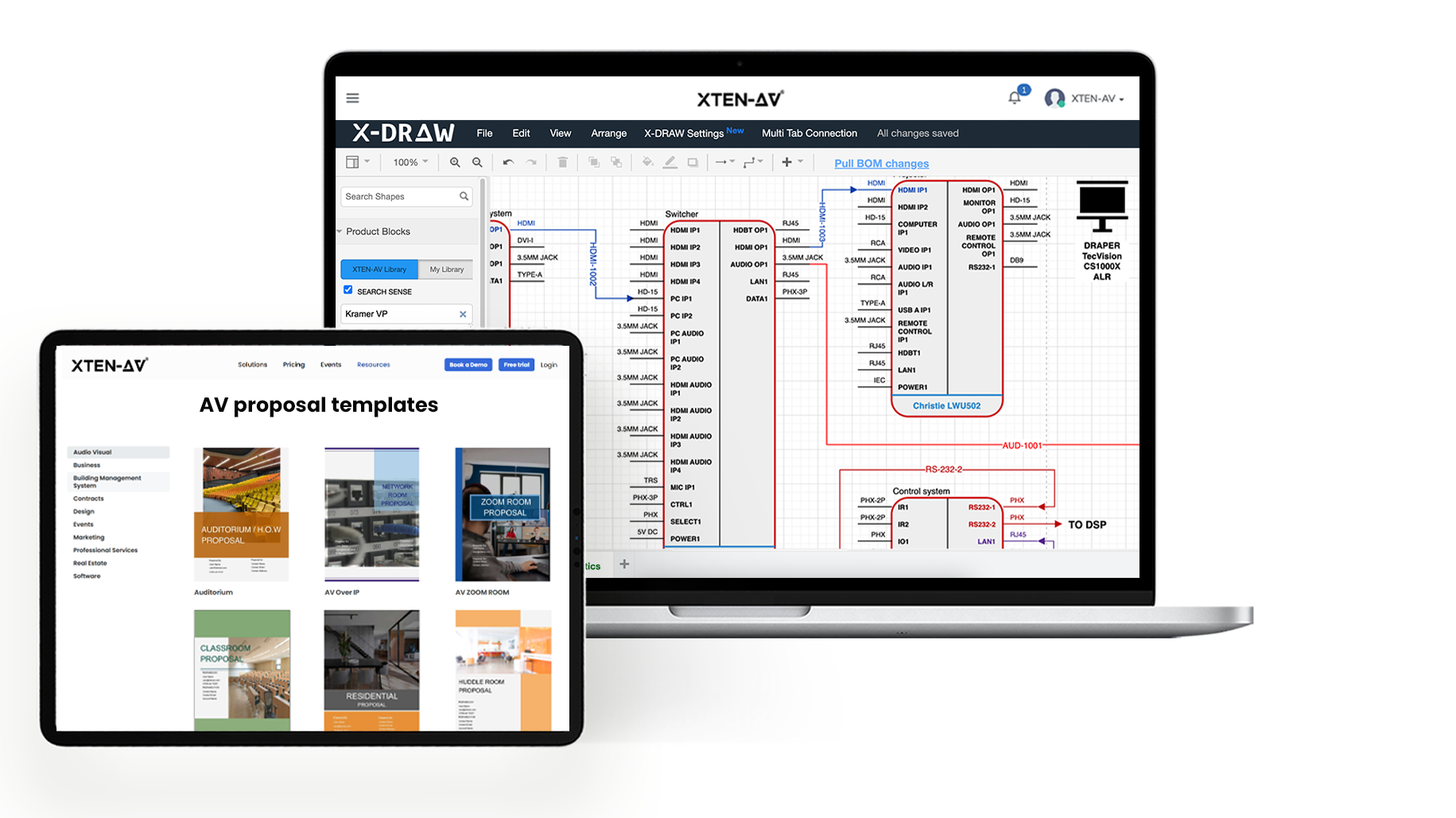
Conclusion
Planning and installing a fire alarm system takes more than just ticking boxes. You need a setup that fits your space, follows code, and makes sense in the real world. and, having the right tools matters just as much as knowing the requirements.
XTEN-AV brings clarity to the entire Fire alarm system installation process. With X-Draw, you can map out the system room by room. XAVIA, the AI assistant, helps you choose the right parts based on your specs. X-DOC gets your proposal ready without juggling extra software. Whether you’re handling a one-off job or offering full fire alarm installation services, this keeps you focused on the work, not stuck fixing paperwork.
Try it once, and you’ll wonder how you ever managed without it.
Register for your 15-day free trial on XTEN-AV and book your free demo, now!
FAQ's
Yes, in most cases. If it’s a hardwired fire alarm system, you really shouldn’t do it alone. You’ll need a licensed professional to do the job. They know how to connect it safely to your power and follow the code. For battery-based alarms, you can install them yourself. But if you’re unsure about placement or don’t want to risk missing coverage, it’s better to get a professional or a fire alarm installation service to handle it properly.
You’ll want one in every critical area. Start with bedrooms, hallways outside sleeping areas, and at least one on each floor. Basements too. Keep them off corners or near fans, vents, or windows where airflow messes with smoke detection. Kitchens? Use heat detectors there, not smoke ones. If you’re unsure about it, a layout created by a security system designer can help. Modern tools like X-Draw make the process smoother for you.
Regular checks are mandatory for fire alarm systems. Most codes recommend doing a full system inspection once a year. But that’s not all. You should test smoke detectors and other key parts more often, like monthly or quarterly. Batteries? Keep an eye on those, too. If your setup is in a commercial building, the rules are even stricter. Regular checks help make sure the system works when there’s an emergency.
Yes, you can install a fire alarm in simple residential settings. But getting it right isn’t just about mounting a few devices. Fire alarm systems have wiring rules, power supply considerations, and compliance codes. If you’re not familiar with those, it’s easy to miss something critical. For homes, DIY might work. For offices or bigger buildings, call someone certified. You’ll sleep better knowing it’s done right, and more importantly, safe.
It depends on the area. Its location and size matter too. For a small home, it might cost just a few thousand rupees. But once you move into commercial buildings or need addressable systems, it gets pricier. The final cost comes down to how big the space is, what type of detectors you need, and whether voice evacuation is involved. Labor and compliance testing can also add up. It’s best to get a site-specific quote instead of guessing from averages.
The process begins with a walkthrough. A technician checks the layout and decides where detectors, control panels, and alarms should go. After that, they run wires or connect wireless devices based on the system type. Each unit is then mounted and tested. For larger buildings, zones are often created to isolate different areas. Once everything is in place, the system is activated and checked for any faults. The main goal is to make sure the system works smoothly in an emergency.
You’ll need at least one smoke alarm in each bedroom. That’s three to start. Then add one in the hallway outside the sleeping areas. If your house has more than one floor, place one on each level. Don’t forget the basement if you have one. That brings it to five or more, depending on layout. Always read your local fire safety codes. They might ask for more. It’s not just about rules. It’s about protecting the people in every room.
It varies according to the space. It could be done in just a few hours for a small house and a simple setup. But for something bigger, like an office or commercial space, it might take a day or two, maybe more. You’ve got wiring, device mounting, testing, all that. Sometimes, you hit delays you didn’t expect. The key isn’t really speed, though. It’s making sure everything is in place and actually works when it counts.
Explore more by topic
AV Design Mastery + Winning Proposals = 10x Productivity!
- Automatic Cable Labeling & Styling
- 100+ Free Proposal Templates
- Upload & Create Floor Plans
- 1.5M Products from 5200 Brands
- AI-powered ‘Search Sense'
- Legally Binding Digital Signatures
No Credit Card Required
Related Blogs

-
- Posted by Sahil Dhingra
Audio Visual Access Control System Installation Guide for Security System Integrators, Designers...
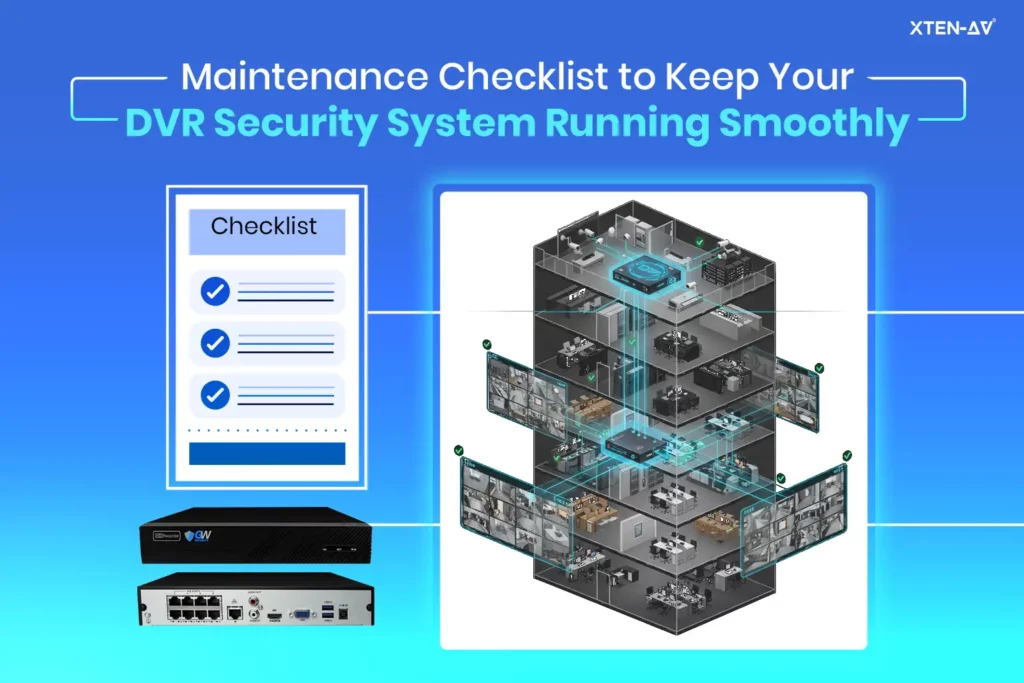
-
- Posted by Sahil Dhingra
Audio Visual DVR Security System Maintenance Checklist Guide Vibhav Singh Published 19...
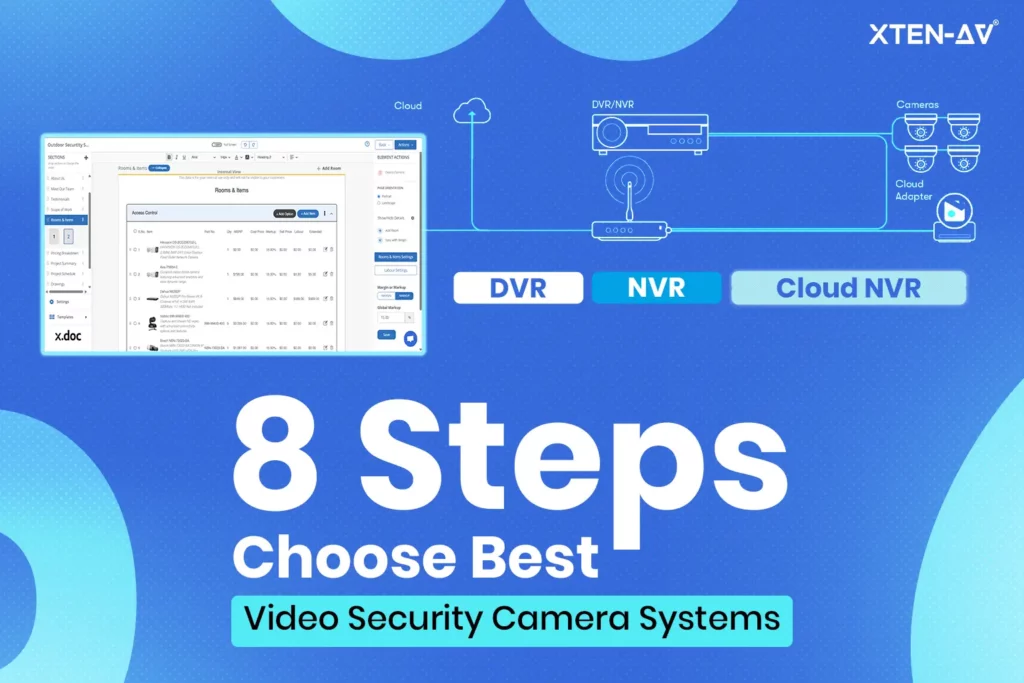
-
- Posted by Sahil Dhingra
Audio Visual How to Choose the Right Video Security Camera System for...
